
There has always been a lot of confusion surrounding Google Panda. And I totally get it. It’s frustrating, scary, and an all-around horrible thing to happen to a website and business owner.
Since February of 2011, I’ve helped a number of companies hit by Google’s Panda algorithm. And if there’s one thing that stands out from those engagements, it’s the incredible amount of confusion circling the mighty Panda.
When speaking with companies that have been hit by Panda, I often explain that the algorithm update should have been named “Octopus” because Panda has many tentacles. Sure, we all know that Panda targets “low-quality content“, but that can mean a lot of things. For example, I’ve seen a range of issues trigger Panda hits, including duplicate content, thin content, doorway pages, low-quality affiliate content, technical problems that caused thin content, cross-linking of company-owned domains, etc.
The fact of the matter is that deciphering a Panda hit can be a tough endeavor for someone who isn’t dealing with SEO on a regular basis. If you don’t target the root of the problem, you have little chance of recovering. And as many business owners find out, the impact from Panda can be felt for a long time (with some websites never recovering).
Getting on the Right Path for Panda Recovery
Unfortunately, I’ve seen many webmasters work on the wrong tasks when trying to fix Panda problems. And that only leads to business owners spinning their wheels, with nothing to show but extreme frustration and anemic trending lines.
Getting on the right path quickly with Panda recovery is critically important and can make sure that valuable action items are being completed on a regular basis. Each change should help a website get closer and closer to recovery, which unfortunately isn’t the case with many sites hit by Panda.
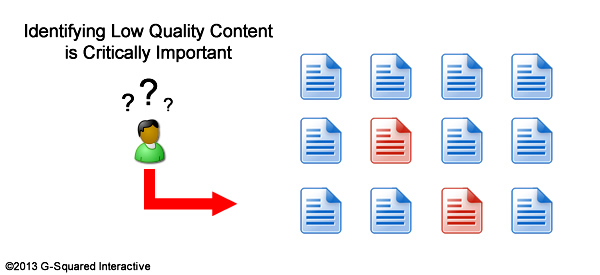
This post isn’t meant to miraculously fix Panda problems, but it is meant to help Panda victims begin to understand what their content quality problems are. The Google Analytics report I cover below could help identify troublesome content that could have led to a Panda hit. This report can start to surface problematic areas of your website that might be the “smoking gun.”
Quick Disclaimer: The following report shouldn’t be the only one you run when analyzing Panda hits. This specific report covers content that was receiving a lot of Google organic traffic prior to a Panda hit. There are times this data can yield serious content quality problems, but there may be other hidden problems causing Panda issues too. Let’s dig into Google Analytics and Excel to compare timeframes.
Comparing Top Landing Pages Prior to and After a Panda Hit
My February post, “The Misleading Sinister Surge Before An Algorithm Hit“, explained a trend I was seeing when analyzing websites mauled by algorithm updates like Panda. I noticed a surge in Google organic traffic leading up to the hit, and I explained why this made sense.
Basically, as websites gain domain authority, they can get away with producing less-than-optimal content (and that content could still rank well). They might start producing thinner content that ends up ranking, over-optimized content that drives a lot of traffic, etc. And as Google drives more traffic to those sites, it gains more intelligence about that content and how users interacted with that content.

And yes, engagement matters for SEO. In particular, dwell time can be a very strong signal that your content is either meeting user expectations, or that it isn’t.
Dwell time is the amount of time between a user clicking through a search result in the SERPs, visiting a page, and then clicking back to the search results. And with extremely low dwell time, users are sending Google and Bing incredible data that the page (probably) didn’t meet their needs.
I won’t go overboard with explaining the ins and outs of dwell time here, but you should understand that each vertical and niche has its own threshold for what’s considered an acceptable dwell time. For example, coupon websites are very different than medical websites providing information about various conditions.
So, as many users began visiting the low-quality content, more negative engagement signals were sent to Google. And at some point, the negative signals tipped the scales, and opened the site up to getting hit by Panda.
‘Percentage Drop’ is a Strong Clue
So, given what I explained about the surge, and the data Google is receiving, it’s a smart move to run a report that shows you the top landing pages from Google organic prior to, and then after, a Panda hit. By running this report, you will not only see the drop in Google traffic per landing page, but the percentage drop as well.
After running the report, exporting the data to Excel, and reviewing the various URLs with the biggest drop, you might find some interesting things. For example, you might find technical problems that caused soft 404s, auto-generated URLs that you didn’t even know were there, serious duplicate content problems, thin content, doorway pages, over-optimization, etc.
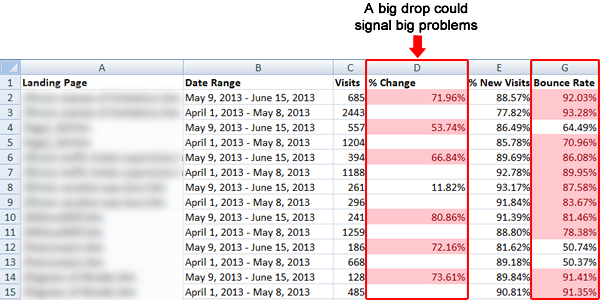
How to Run a Top Landing Pages Report in Google Analytics
There are several ways to run a Top Landing Pages Reprt from Google organic in Google Analytics (with date comparison), and I’ll cover one of those methods in detail. I have created a step-by-step tutorial for creating the report in Google Analytics, which explains how to export it to Excel, and then how to polish off the report with some Excel magic. But I won’t cover the tutorial here on Search Engine Watch (this post was already getting too long).
Instead, you can head over to my blog to read the tutorial, follow the steps, and create your own Panda report. I recommend reading the rest of this post now on Search Engine Watch, and then heading over to the tutorial to learn how to create the report. Then you can be off and running with your own analysis.
And remember, this shouldn’t be the only report you run. A rounded analysis can help you identify a range of problems from a “content quality” standpoint. In other words, pages not receiving a lot of traffic could also be causing Panda-related problems. But for now, let’s analyze the pages sending Google the most data before Panda attacked.
Follow this link to view the tutorial for creating a top landing pages report in Google Analytics.
Analyzing The Data
Once you have your landing page data from Google organic, and you have identified URLs that showed a steep drop after a Panda hit, you need to dig into that data. Remember, these URLs are the ones that were receiving the most traffic from Google prior to Panda arriving. Review those URLs heavily to identify potential content quality problems.
There are times I check URLs in the report and find problems immediately, while other times it takes more in-depth analysis.
For example, you might find:
- Multiple URLs ranking that can contain the same, or very similar content, yet they are optimized differently (doorway page-like).
- Pages with just a few lines of copy (thin content).
- Broken pages (design and/or content problems that make the page unreadable).
- Pages that contain content copied from other websites (scraping or a complete “lifting” of the content).
- Low-quality affiliate content.
Crawl the Landing Pages for More Data
Don’t stop here. In addition to manually analyzing those URLs, crawl them with a tool like Screaming Frog. Then you can gather data en masse, like header response codes, title tags, metadata, file size, canonical data, meta robots directives, etc. And all of that data can help you analyze content quality.
For example, I’ve helped a number of companies that had technical issues creating serious Panda-like problems. Without digging into site from a technical standpoint, I never would have found those problems.
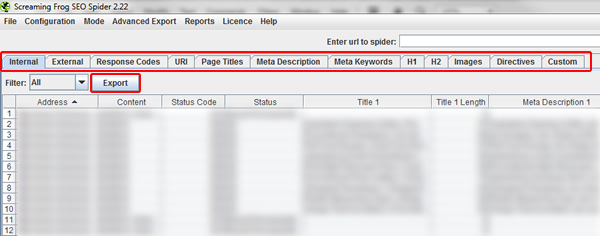
Understand Engagement (Bounces and Adjusted Bounces)
The spreadsheet you will create via my tutorial has several other pieces of data you should analyze. For example, bounce rate can be a telling story.
If a page received 17,400 visits during the pre-Panda timeframe, and it had an 86 percent bounce rate, then 14,964 visits bounced off the page. That’s 86 percent of visits landing on that page, not visiting any other pages, and leaving the site. Depending on the purpose of the landing page at hand, high bounce rates can signal serious content quality problems.
But be careful with standard bounce rate. It’s a flawed metric.
If someone visits your page, spends 10 minutes reading through a killer post of yours and leaves, then it’s still a bounce. But is that really a bounce? Would Google see that as problematic? No, it probably wouldn’t.
I recommend implementing Adjusted Bounce Rate (ABR) to get a better view of actual bounce rate. Adjusted Bounce Rate takes into account time on page, which can get you closer to actual bounce rate percentages.

For example, if you set an ABR threshold at twenty seconds, and still have a high ABR percentage, then visitors clearly aren’t engaging with your content. Again, the time threshold you use completely depends on your vertical, so 20 seconds might be acceptable for some sites, while others might require one minute or greater.
Bonus Report: Top Pages in Google Webmaster Tools
If Google Panda has hit your site, hopefully you’ll run to Google Analytics now to run the Top Landing Pages Report (with comparison). But that’s not the only way to identify problematic content.
Sure, that report gives you top landing pages from Google organic (based on Google Analytics data), but what if certain pages weren’t tagged properly? What if someone hacked your site and added pages that don’t contain your GA snippet? You might never know those pages are there and causing problems until it’s too late.
Google Webmaster Tools to the Rescue
If you access Search Queries reporting in Google Webmaster Tools, there’s a tab for “Top Pages” next to “Top Queries”. That will show you the top pages from your website ranking in Google (receiving impressions and clicks via various keywords). You’ll also see click-through rate and average position.
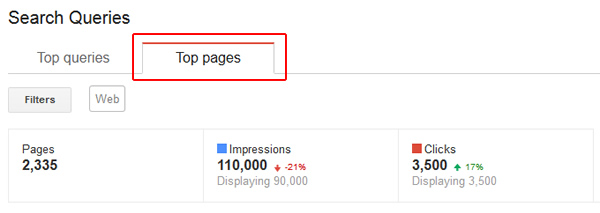
If you scan through the list of top pages, you might see URLs that didn’t show up in your Google Analytics reporting! Note, this just happened when I was analyzing the data from a company that got hit by Panda and reached out to me for help. There was a large discrepancy between the GA and GWT data, and I found a number of problematic pages ranking in Google and driving traffic (and the company had no idea the pages were there). They ended up removing many of those pages quickly and investigating the issue.
Similar to what we did earlier with the top landing pages report, you can export the data to Excel for deeper analysis. And remember, you can always click the “with change” button in Google Webmaster Tools to see the percentage change for each column (as long as it’s within the past 30 days).
If you were hit by and algorithm update, then using this feature can help you identify pages that saw a steep drop in impressions, clicks, and average position after the algo hit occurred. Then you can dig in further to identify what happened, why those pages were impacted, etc.
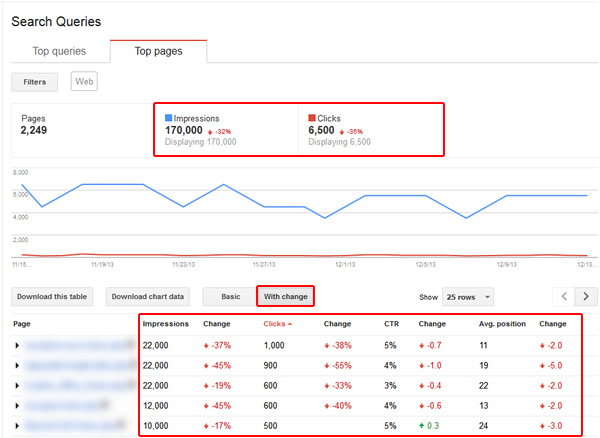
Summary – Analyzing Content Through a Panda Lens
Google Panda recovery isn’t easy, but it is possible.
Unfortunately, understanding why Panda arrived is often a confusing subject for webmasters that have been impacted. And that’s why it’s critically important to get on the right track quickly.
One way to do that is to analyze the top pages that Google was driving traffic to prior to the algorithm update. Remember, that’s where Google is gaining the most intelligence about your content based on user engagement data.
Analyzing that content can help provide answers to low-quality content questions that follow a Panda hit. Start there and heavily analyze those URLs. Good luck.







